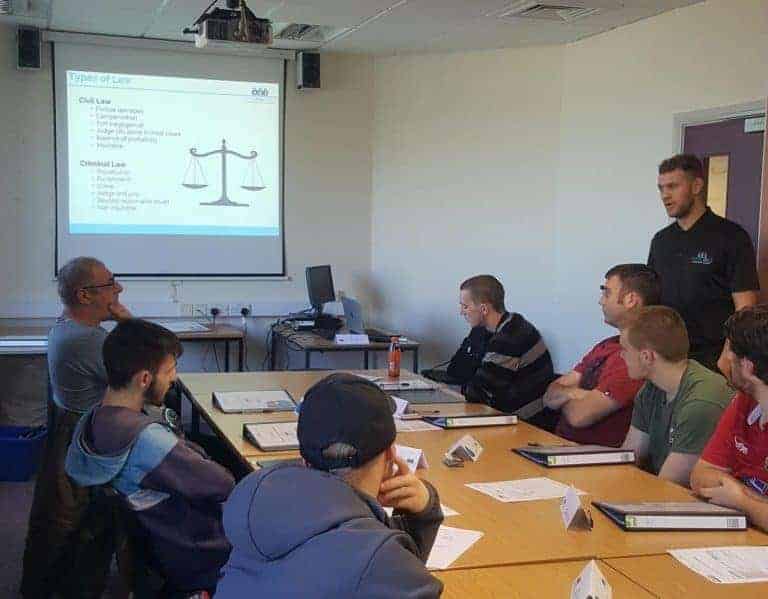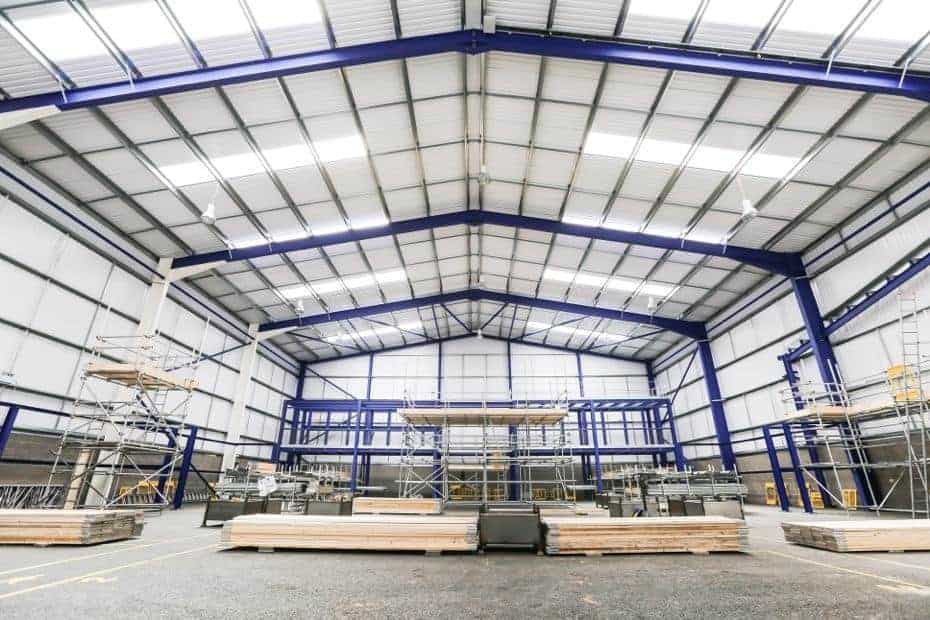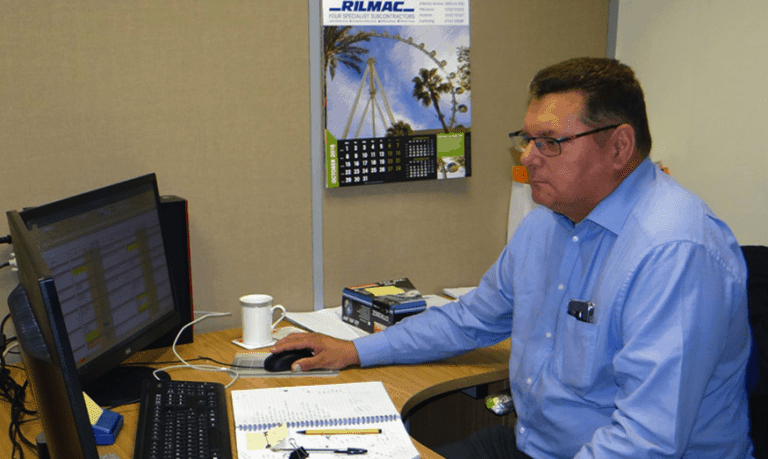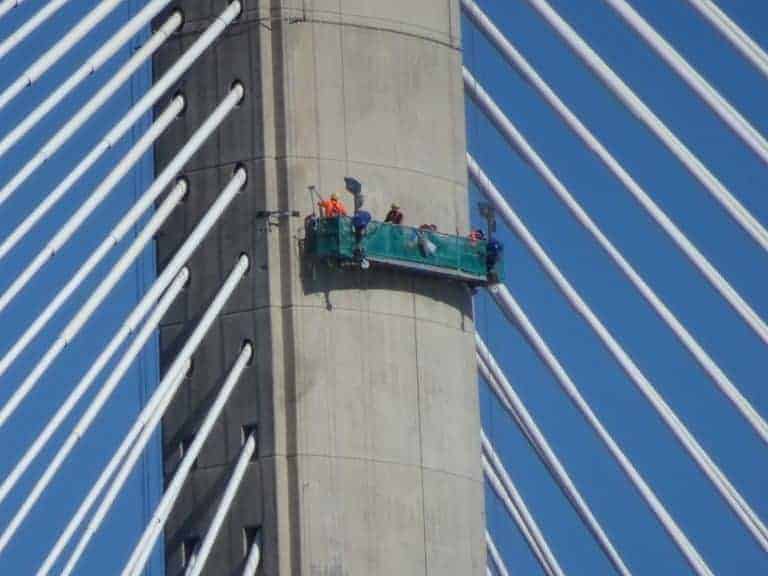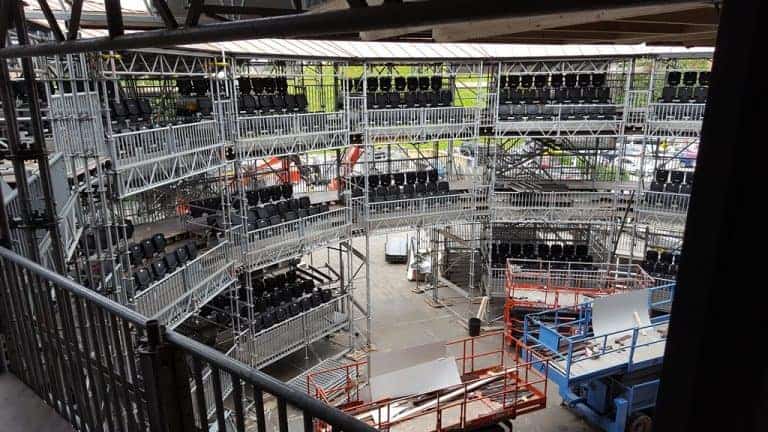One dead after scaffolding collapse in Belgium
Seven stories high scaffold has collapsed killing one and seriously injuring another at a hotel building in Antwerp, Belgium.
The collapse is positioned directly outside the busy central station. Emergency response teams were in attendance at the scene to see if anyone was trapped.
One person has died and another has been seriously injured in the collapse according to reports.
It is still unclear why the scaffolding collapsed.
Altrad Cape awarded three-year scaffolding contract in KSA
Altrad has announced its Kingdom of Saudi Arabia (KSA) subsidiary, RB Hilton Saudi Arabia, has secured a three-year maintenance contract with Sadara Chemical Company for the provision of scaffolding services.
The contract value for the three year period (plus 2 years optional) is estimated to be US$ 5M starting from December 2018.
Established in October 2011, Sadara is a joint-venture developed by the Saudi Arabian Oil Company (Saudi Aramco) and The Dow Chemical Company (Dow). It is an unprecedented undertaking – the world’s largest chemical complex ever built in a single phase, with 26 integrated world-scale manufacturing plants and capacity of over 3 million metric tons per annum. Sadara supports Saudi Arabia’s industrial and social diversification by extending key value chains downstream.
Altrad Cape says this award is a major strategic win for RB Hilton, providing them with an opportunity to develop a long-term relationship with Sadara chemical company.
Managing Director of the KSA Business Paul Cockerill commented: “We are delighted to secure this long-term contract with Sadara and increase our maintenance coverage within the kingdom”.
West Anglian Training Association falls into Administration
A leading scaffolding training provider has ceased trading leaving many scaffolders deeply concerned they will be left out of pocket.
According to sources the Cambridgeshire based training firm West Anglian Training Association Ltd (WATA) unexpectedly fell into administration yesterday (17th Oct). WATA provided a broad range of training including scaffolding, health, safety and environmental, quality management, electrical and mechanical skills training. Many people that had already booked and paid for courses were informed with a phone call from WATA explaining the position of the business and that all courses had been canceled. Paul Oldfield who had paid WATA £1,200 was due to start his CISRS Part 1 Course on the 29th said: “I got a phone call yesterday from WATA, they told me they had gone into administration and had canceled all courses. “When I asked for a refund they said they were sending out letters so people could claim. I’m pretty sure I won’t see my money again,” Oldfield added. The Construction Industry Scaffolders Registration Scheme (CISRS) posted a message on their website after the scheme’s helpline was inundated with calls from disgruntled WATA customers asking for advice. CISRS Scheme Manager said: “It was very disappointing to hear that WATA had ceased trading, this was not something we were expecting. We have great sympathy for those who have paid up front for training and may well now lose their money. “CISRS has left messages with the administrators in order to let us know what actions those affected can take and also if we can retrieve any portfolio’s, training records or certificates so people may continue their training with another provider. “We are currently speaking to other CISRS providers to see if they can assist in any way.” ScaffMag understands that Mctear, Williams and Wood are acting as interim administrators Tel. 0800 331 7417 https://www.mw-w.com We have reached out to WATA for comment, and await their reply.Three injured after Cotswolds scaffolding collapse
Three workers were taken to hospital after a scaffolding collapsed on a Church in the Cotswolds.
Local media has reported that on Tuesday afternoon (October 16) scaffolding that was erected for roofing works collapsed at an address in Church Westcote near Chipping Norton. Three men were injured in the collapse and taken to a nearby Hospital in Oxford. Two of the men are believed to have suffered non-serious injuries while the extent of the other man’s injuries is unknown. Ambulance and fire services attended the scene. Crews from Moreton and Stow fire services assisted in the rescue of the casualties. Fire officer Ian Tonner tweeted: “Excellent to oversee Moreton and Stow crews at this incident earlier. “Four people rescued and safe systems of work put in place to ensure no more danger. The Health & Safety Executive is aware of the incident.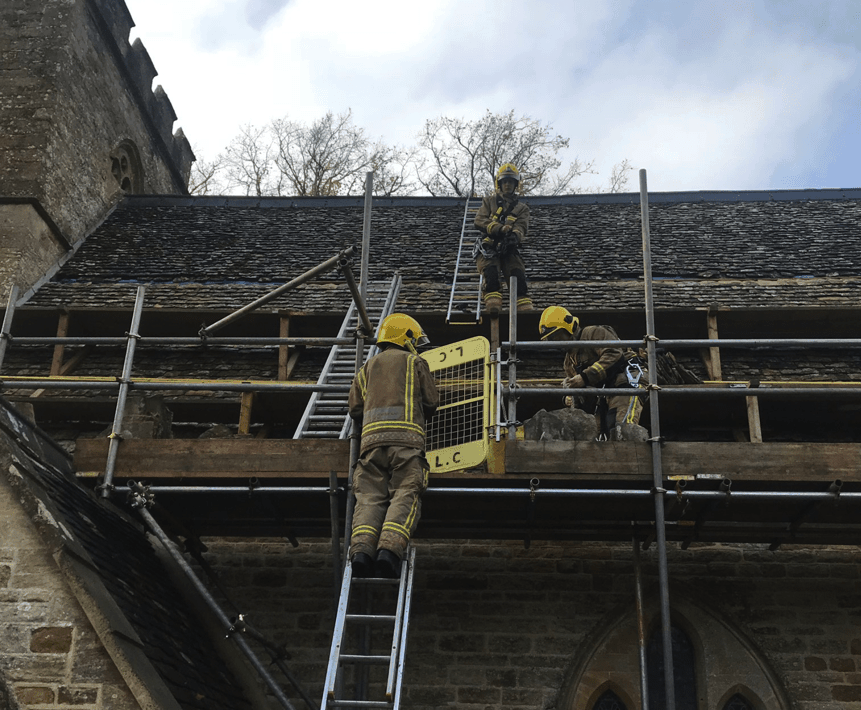
Scaffolding Director Sentenced for VAT Fraud
A scaffolding company director has been sentenced for almost £100,000 tax fraud that she tried to blame on an innocent employee.
An HM Revenue and Customs (HMRC) investigation found that AIM Access Solutions Ltd director, Amanda Noble, lied on her VAT returns. She had submitted more than 40 false invoices to evade paying £98,000 from her company.
The VAT returns for the Liverpool-based business included many invoices for work falsely claimed as zero-rated, so no VAT was paid.
According to The Business Desk investigators from HMRC questioned Noble about the problem, but she insisted an employee dealt with the VAT returns and she never looked at them. It was revealed she had lied about the employee.
She admitted making the false VAT submissions and said it was initially a genuine mistake but continued making the false claims to keep the money with the intention of repaying HMRC once the business was in better financial health.
She paid the VAT after HMRC launched a criminal investigation and uncovered the fraud.
“She shamelessly tried to blame an entirely innocent employee.
“Noble only paid the tax due when she became subject to a criminal investigation.”
He added: “We will ensure the honest majority are not cheated by tax fraudsters, like Noble. Anyone with information about tax fraud can report it to HMRC online or call us on 0800 788 887.”
Noble admitted the fraud at Liverpool Magistrates Court on September 4, 2018. She was sentenced to 16 months in jail, suspended for two years, at Liverpool Crown Court. And also ordered to complete 80 hours of unpaid community work with a 10-day Rehabilitation Activity Requirement.
The full amount owed to HMRC has now been repaid.
Rilmac Scaffolding Appoints New Southern Director
Rilmac Scaffolding Ltd has announced the appointment of Paul Wallis in the role of Director – Southern. Wallis will be based at the Rilmac Depot in Northampton and have responsibility for the whole southern region, including London and the Home Counties.
The Northampton Depot has seen impressive growth since opening just over three years ago and Wallis will be looking to grow on the success, overseeing such prestigious projects as the scaffolding for a new student accommodation village at Warwick University.
Rilmac says Paul has over 30 years’ experience in the scaffolding industry, most recently as General Manager for Hallam Scaffold Ltd. His vast experience and depth of knowledge will be a great addition to the team.
In his free time, Paul is a bit of a petrolhead, driving fast cars and attending many motorsport events. He is hoping to get away from the grid quickly as he settles into his new role!
Denholm Industrial Acquires Access Systems Provider ALPS
Denholm Industrial has announced the acquisition of Access Lifting Pulling & Safety Ltd, commonly known as ALPS, which was completed on 14th September 2018 for an undisclosed sum.
The acquisition expands Denholm Industrial’s existing engineered capabilities on structures that are difficult to access and the combined capabilities establish a fully comprehensive scaffolding and access solutions provider.
Based near Sheffield, ALPS designs and implements bespoke engineered access solutions and specialises in suspended access and lifting applications. The company has developed its skills, expertise and methodologies to safely deploy suspended access equipment, modular mobile platforms and specialist industrial rope access technicians, overcoming the challenges of accessing large or complex structures that are difficult or impractical to access using conventional scaffolding methods.
The acquisition of ALPS enhances the existing engineered scaffolding and access capabilities of Denholm Industrial and its subsidiaries and the combined businesses provide a fully comprehensive single-supplier service that offers flexible and efficient access solutions.
 Denholm Industrial Group Managing Director Steve Hill said: “ALPS has a track record of accessing some of the UK’s most iconic and difficult to reach landmarks and structures and combining our skills and competences creates an attractive proposition for customers of ALPS, Denholm Industrial Services and SES, our Midlands-based scaffolding business. Together, we offer a comprehensive set of capabilities to meet both routine and bespoke access requirements, which reduces the number of on-site interfaces for our customers when they are managing major construction, maintenance and repair projects.”
David Simm of ALPS said: “Combining the skills, experience and expertise of ALPS and Denholm Industrial was compelling for me. We have developed and honed our specialist access skills over the past 20 years, particularly as structures have become bigger and more challenging to access. Similarly, Denholm Industrial has built up a family of recognised and well-respected scaffolding and access brands and as part of a larger family-run group, shares our work ethic and total commitment to health and safety. The acquisition of ALPS by Denholm Industrial establishes a truly complete engineered access solutions provider.”
The acquisition of ALPS by Denholm Industrial follows previous acquisitions of Elite Scaffolding in April 2018 and Scaffold Erection Services (SES) in May 2016, two well-regarded access and scaffolding companies in the south west of England and the Midlands respectively.
Denholm Industrial Group Managing Director Steve Hill said: “ALPS has a track record of accessing some of the UK’s most iconic and difficult to reach landmarks and structures and combining our skills and competences creates an attractive proposition for customers of ALPS, Denholm Industrial Services and SES, our Midlands-based scaffolding business. Together, we offer a comprehensive set of capabilities to meet both routine and bespoke access requirements, which reduces the number of on-site interfaces for our customers when they are managing major construction, maintenance and repair projects.”
David Simm of ALPS said: “Combining the skills, experience and expertise of ALPS and Denholm Industrial was compelling for me. We have developed and honed our specialist access skills over the past 20 years, particularly as structures have become bigger and more challenging to access. Similarly, Denholm Industrial has built up a family of recognised and well-respected scaffolding and access brands and as part of a larger family-run group, shares our work ethic and total commitment to health and safety. The acquisition of ALPS by Denholm Industrial establishes a truly complete engineered access solutions provider.”
The acquisition of ALPS by Denholm Industrial follows previous acquisitions of Elite Scaffolding in April 2018 and Scaffold Erection Services (SES) in May 2016, two well-regarded access and scaffolding companies in the south west of England and the Midlands respectively.
 Denholm Industrial Group Managing Director Steve Hill said: “ALPS has a track record of accessing some of the UK’s most iconic and difficult to reach landmarks and structures and combining our skills and competences creates an attractive proposition for customers of ALPS, Denholm Industrial Services and SES, our Midlands-based scaffolding business. Together, we offer a comprehensive set of capabilities to meet both routine and bespoke access requirements, which reduces the number of on-site interfaces for our customers when they are managing major construction, maintenance and repair projects.”
David Simm of ALPS said: “Combining the skills, experience and expertise of ALPS and Denholm Industrial was compelling for me. We have developed and honed our specialist access skills over the past 20 years, particularly as structures have become bigger and more challenging to access. Similarly, Denholm Industrial has built up a family of recognised and well-respected scaffolding and access brands and as part of a larger family-run group, shares our work ethic and total commitment to health and safety. The acquisition of ALPS by Denholm Industrial establishes a truly complete engineered access solutions provider.”
The acquisition of ALPS by Denholm Industrial follows previous acquisitions of Elite Scaffolding in April 2018 and Scaffold Erection Services (SES) in May 2016, two well-regarded access and scaffolding companies in the south west of England and the Midlands respectively.
Denholm Industrial Group Managing Director Steve Hill said: “ALPS has a track record of accessing some of the UK’s most iconic and difficult to reach landmarks and structures and combining our skills and competences creates an attractive proposition for customers of ALPS, Denholm Industrial Services and SES, our Midlands-based scaffolding business. Together, we offer a comprehensive set of capabilities to meet both routine and bespoke access requirements, which reduces the number of on-site interfaces for our customers when they are managing major construction, maintenance and repair projects.”
David Simm of ALPS said: “Combining the skills, experience and expertise of ALPS and Denholm Industrial was compelling for me. We have developed and honed our specialist access skills over the past 20 years, particularly as structures have become bigger and more challenging to access. Similarly, Denholm Industrial has built up a family of recognised and well-respected scaffolding and access brands and as part of a larger family-run group, shares our work ethic and total commitment to health and safety. The acquisition of ALPS by Denholm Industrial establishes a truly complete engineered access solutions provider.”
The acquisition of ALPS by Denholm Industrial follows previous acquisitions of Elite Scaffolding in April 2018 and Scaffold Erection Services (SES) in May 2016, two well-regarded access and scaffolding companies in the south west of England and the Midlands respectively. Four Workers Dead After Scaffolding Collapses At Multi Storey Building
A large section of scaffolding has collapsed after a tractor-trailer, used for loading and unloading materials, accidentally backed into the scaffolding according to sources.
Four construction workers were killed and five injured on Sunday after the accident that happened at a multistorey building under-construction in Noida, India.
Police have said the accident seemed to have occurred because a tractor-trailer backed into the structure. The entire section collapsed bringing the workers down with it and falling onto the tractor killing the driver. The injured workers were rushed to various hospitals but three other workers succumbed to their injuries and were pronounced dead.
Police are investigating the accident and safety lapses on the site. A police spokesperson said: “There definitely would have been some safety lapses. If the structure was sturdy enough, it wouldn’t have collapsed in this manner.”
A stonemason who had been working on the site alleged that the accident was due to negligence he said: “The ties that hold the scaffolding to the building were removed during the process of attaching glass. This caused the scaffolding to become unstable.”
Layher Scaffolding and Event Systems Take Centre Stage
The use of Layher scaffolding, access and event equipment for a specialist project in York undertaken by Acorn Events Structures is, in every sense, dramatic.
Award-winners Acorn have designed and installed a faithful recreation of Shakespeare’s celebrated Rose Theatre for Lunchbox Productions who are running a series of theatrical events throughout the summer and autumn at the site. “The project is a genuine ‘one-off’ and huge credit is due to Acorn Managing Director, Andy Nutter and his team,” says Sean Pike, Layher’s UK Managing Director. “Their use of a wide range of our scaffolding and event products pays testimony to both their ability and creativity and the versatility of our equipment, and we are delighted to have played a key role in the work.” The remarkable structure reflects both the design and functional elements of the original ‘London Rose Playhouse’ that dates from 1587. The 13-sided design can accommodate a full width two-level stage together with an audience numbering 600 on three covered tiers, with a further 350 ‘groundlings’ underneath an open roof. “The theatre utilises 1500 square metres of corrugated iron panels and timber elements, but the main supporting structure itself has been created using Layher’s equipment including the company’s Allround scaffolding and event seating systems,” says Andy Nutter at Acorn Events. “The roof over the seating blocks, both upper and lower stage platforms, on-stage staircases and a beamed roof across the stage also feature Layher equipment with its ease of handling, choice of fixing positions and integration all key considerations.” Built in less than three weeks on a car park in the centre of York, the Rose Theatre Project is part of a regional commitment to bringing exciting theatrical experiences to the north of England. Its thoroughly bespoke nature and the requirement to follow a very rigid, historical layout and dimensions are reflected in both Acorn Event’s capabilities and the suitability of Layher equipment to meet the requirements of projects of all shapes and sizes.
“We are delighted to be part of such an important local project which creates a cultural legacy for our community while supporting local industry,” adds Andy Nutter. “We’ve worked closely with our client to design and engineer a unique and functional performance area which positions audience members within just 15 metres of the action, with the aim of presenting Shakespeare’s plays in a similar environment to that which would have been enjoyed 400 years ago.”
“It is a highly impressive blend of historical objectives and modern methods of construction, and everybody concerned should take a bow for their performance,” concludes Sean Pike.
Built in less than three weeks on a car park in the centre of York, the Rose Theatre Project is part of a regional commitment to bringing exciting theatrical experiences to the north of England. Its thoroughly bespoke nature and the requirement to follow a very rigid, historical layout and dimensions are reflected in both Acorn Event’s capabilities and the suitability of Layher equipment to meet the requirements of projects of all shapes and sizes.
“We are delighted to be part of such an important local project which creates a cultural legacy for our community while supporting local industry,” adds Andy Nutter. “We’ve worked closely with our client to design and engineer a unique and functional performance area which positions audience members within just 15 metres of the action, with the aim of presenting Shakespeare’s plays in a similar environment to that which would have been enjoyed 400 years ago.”
“It is a highly impressive blend of historical objectives and modern methods of construction, and everybody concerned should take a bow for their performance,” concludes Sean Pike. 